Cats play fetch because that’s a natural hunting behavior inherited from their wild ancestors. If you own an outdoor cat, you’ll most likely have seen her fetching a prey item, such as a bird or mouse, back to your home and presenting the unfortunate creature as a gift by dropping it on your doorstep!
You can help replicate that behavior in your cat’s play by teaching her to play fetch, and yes, cats do play fetch. All you need to do is use one of your cat’s favorite toys, toss it a short distance from her, and encourage her to fetch it. Use positive reinforcement techniques and reward your cat, and she will likely repeat the behavior in the future.
Training your cat to play fetch provides physical activity and mental stimulation and relieves stress, so why not get started today?
Keep reading to learn more about how to teach a cat to play fetch!
How Do You Teach Your Cat To Fetch?
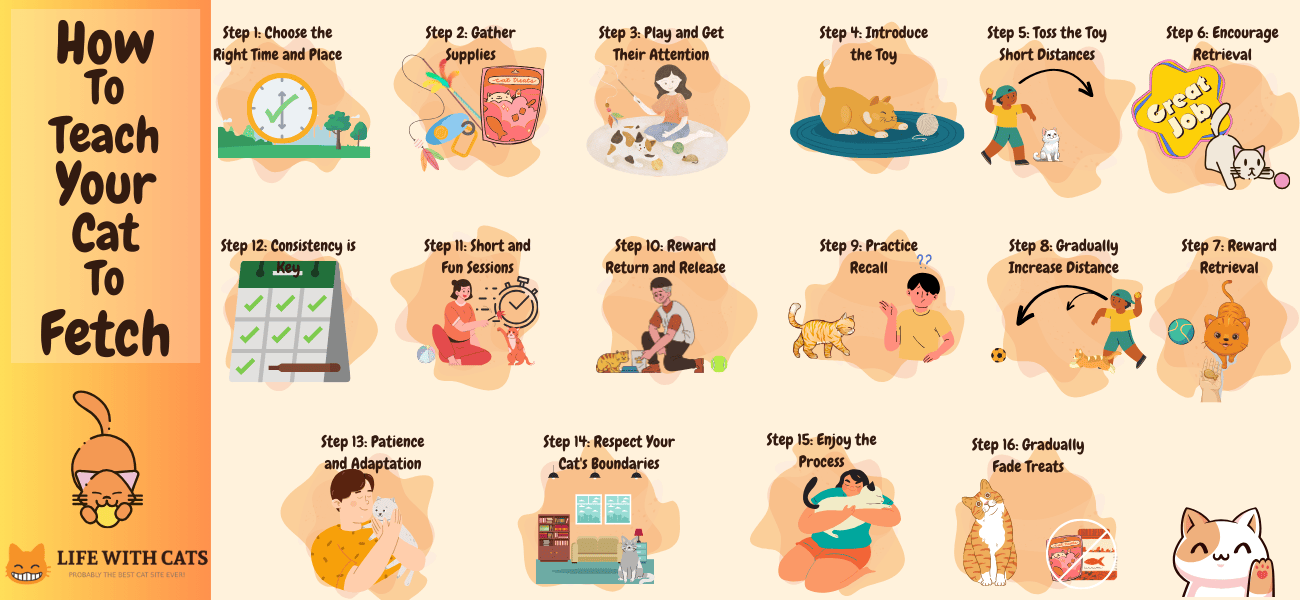
To teach your cat to fetch, you’ll need a cat fetch toy, patience, and time to set aside during the day for fetch training. You’ll need to buy a few things for your training, such as a clicker (if using one), some treats, and a suitable lightweight toy for your cat to fetch.
Keep reading to learn how to teach your cat to fetch!
Step 1: Choose the Right Time and Place
Cats have a relatively short attention span and are easily distracted, so you must choose somewhere quiet with plenty of space for your training sessions.
Choose a time when your cat is not hungry, tired, or expecting to be let out. That way, you’ve more chance of keeping her attention and having a productive training session.
Step 2: Gather Supplies
Before you start training, gather the supplies you’ll need, including the following:
- Clicker (if you’re using one)
- Training treats
- A lightweight, easy-to-carry toy.
You want to have everything you need on hand before you begin. You don’t want to break off training to go and get something you forgot.
Step 3: Play and Get Their Attention
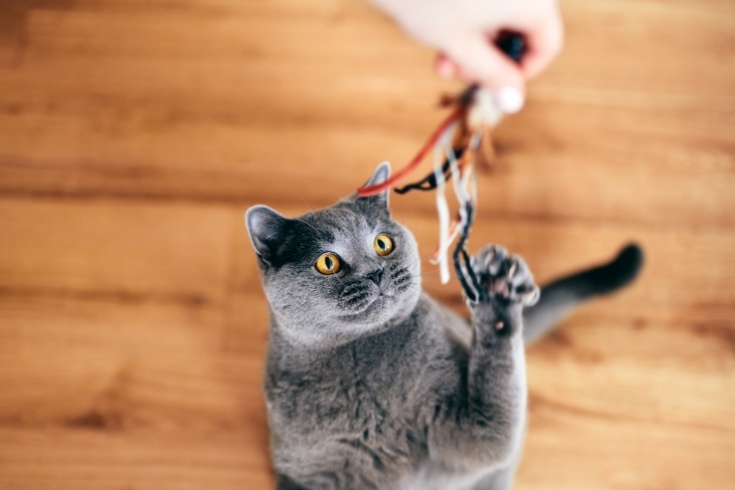
Get your cat’s attention by initiating a game with her. That can be any kind of game that interests your cat, but don’t tire her out too much before you start your fetch training.
Step 4: Introduce the Toy
Choose a lightweight toy, such as a ball or catnip mouse, and allow your cat to sniff it. Hopefully, she’ll show an interest and want to play with it.
Step 5: Toss the Toy Short Distances
Toss the toy a short distance from your cat, praising her when she runs after it and rewarding her with a treat.
Step 6: Encourage Retrieval
When your cat approaches the toy, verbally encourage her to retrieve it. You can use any verbal cue you want, although “fetch” is the obvious one to go for!
Step 7: Reward Retrieval
If your cat brings you the toy, praise and reward her with a treat or lots of fuss and cuddles. That teaches your cat she’s done the right thing, making her more likely to repeat the behavior in the future.
Step 8: Gradually Increase Distance
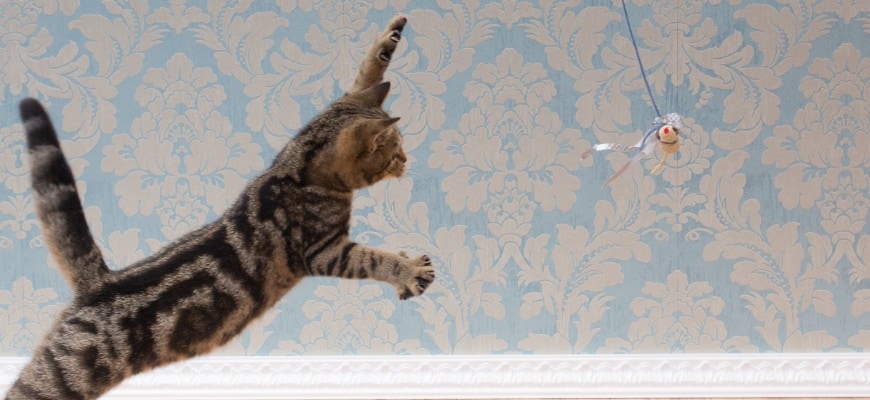
Next, up the ante by throwing the toy a bit further away from your cat to make the game more challenging for her.
Step 9: Practice Recall
They say that practice makes perfect, and that’s certainly the case when training your cat to fetch! So, practice recall with your cat throughout each training session, so that she comes straight back to you and brings the toy with her.
Remember to use positive reinforcement and give your cat a treat reward or make a fuss of her as soon as she comes to you with the toy. Your cat will then associate something pleasant and positive with fetching her toy, making her more likely to repeat the behavior in the future.
Step 10: Short and Fun Sessions
Cats have a relatively short attention span and can become bored quite quickly, so be sure to keep your training sessions short and make them fun. That way, your cat will be more likely to engage with you during training because she’s having such a great time.
Step 11: Consistency is Key
Be consistent with your commands so that your cat understands what you want her to do. Choose a keyword and stick to it to avoid confusing your cat. Also, if your family is helping with the training process, ensure they use the same verbal cues as you so that your furry friend doesn’t get confused.
Step 12: Patience and Adaptation
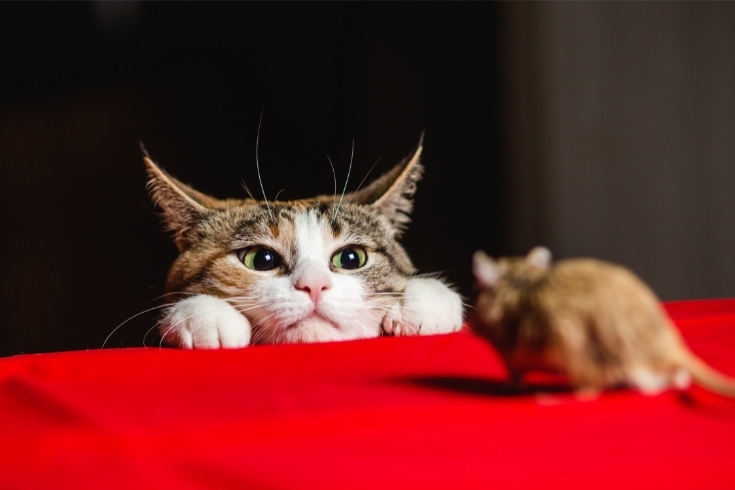
As with all training exercises, you’ll need to be patient and not expect your cat to understand what you mean straight away. You might also find you need to adapt your training methods to suit your pet. For example, your cat might not want to fetch a ball, so you’ll need to choose something more tempting like a catnip mouse.
Step 13: Respect Your Cat’s Boundaries
Don’t push your cat too far. If your pet gets tired or loses interest in the game, finish on a positive note by asking her to perform a trick or command she’s familiar with, and then call it a day. You can start again tomorrow.
Step 14: Gradually Fade Treats
Once your cat gets the hang of the game, don’t reward her with a treat every time she brings the toy to you. Ideally, you want your cat to perform the trick because it’s fun and she wants to please you rather than because she’s looking for a reward.
Do Cats Plat Fetch?
Yes, cats play fetch in their own way. Fetching a toy or other object uses the same instincts as catching prey and bringing it back to the cat’s family as a meal.
Why Do Cats Play Fetch?

Cats primarily play fetch because they have a natural hunting instinct to bring prey items back to their den and hungry families. But there are other reasons, too, as we explain below.
Hunting Instinct
As mentioned before, cats fetch items to their owners and sometimes bring them to other cats because of their innate hunting instinct. In the wild, a cat fetches a dead animal back to its kittens to provide them with a meal, so when your cat arrives with a catnip mouse for you, she’s really just imitating what she would do in the wild environment. Allowing your cat to indulge her natural hunting behaviors is a good way of keeping your pet stress-free and grounded, so, don’t put her off!
Bonding
Bringing you a toy or other object is your cat’s way of expressing her love for you as a member of her family. So, when your kitty brings you a toy, it’s a way of bonding with you.
Exercise and Stimulation
Cats often play fetch as a way of getting exercise and mental stimulation. Playing a game that allows the cat to express its natural behaviors also helps to relieve stress.
Sensory Stimulation
Learning to play fetch is a great way of stimulating your cat’s senses and providing a natural form of exercise. For example, your cat must use her senses of sight, hearing, touch, and smell to “hunt” the toy and her sense of touch to retrieve it.
Imitating Dogs or Humans
Although highly unlikely, it is possible that your cat might be copying your dog or even you when she retrieves a toy on command.
Individual Personality
Some cats are more playful and willing to learn than others, so your pet’s individual personality will often determine how successful your training efforts are.
What Are the Things You’ll Need to Teach Your Cat to Play Fetch?
The things you’ll need to teach your cat to play fetch are a clicker, treats, a suitable lightweight toy, time, patience, and positive reinforcement. You can find most of these things from your local pet store or online, although positivity, patience, and time are only available directly from you!
Clicker
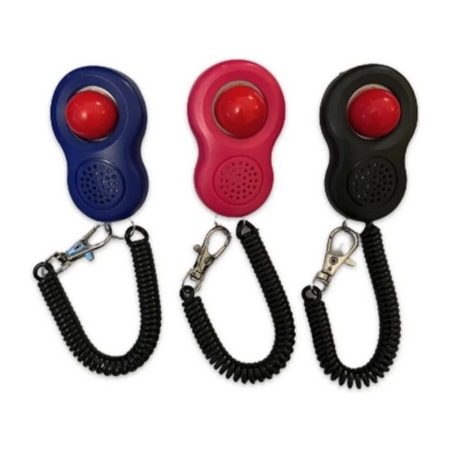
A clicker is a small handheld device that makes a click when you squeeze it. Whenever your cat successfully retrieves her toy, click the clicker and reward her. The cat eventually learns that the click means a treat and is more likely to repeat the behavior in the future.
Treats

Treats are essential for rewarding your cat when she does what you want, so you’ll need a good supply of high-quality rewards for your pet.
Interactive Toys
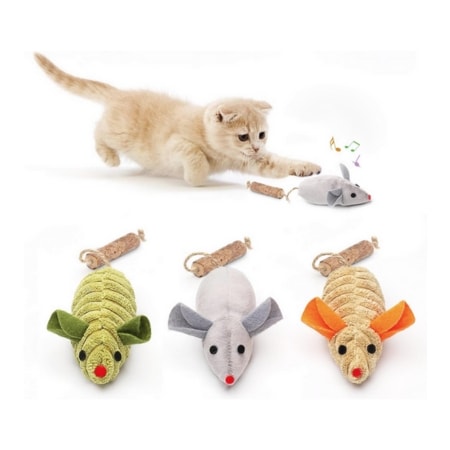
You’ll need some interactive toys to encourage your cat to join in the game. Choose things you know your cat loves to play with, such as catnip mice, lightweight balls, and the like.
Patience and Persistence
Although you can’t buy them on Amazon, patience and persistence are crucial things you need when training your cat to play fetch. If the penny doesn’t drop at first, keep going until you get the result you want.
That said, if your cat simply refuses to play, you might need to admit defeat!
Positive Reinforcement
Always use positive reinforcement when training your cat. Positive reinforcement means rewarding your pet when she does something good or displays a behavior you want. The cat then associates the behavior with the reward and will be more likely to repeat it in the future.
Conclusion
Wild cats bring prey items to their families to share, and your pet cat retains that natural instinct. Let’s face it, most cat owners have received a “gift” from their furry friend, so it’s pretty easy to teach your cat to fetch a lightweight ball or catnip mouse. The trick is to have your pet retrieve the toy whenever you ask her to.
Teaching your cat to retrieve a toy is excellent physical exercise for your pet, provides her with mental stimulation, and helps relieve stress. You need a clicker, some training treats, a toy, and plenty of patience and time to teach your cat this fun trick.